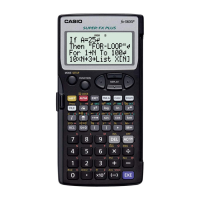E-16
A
Number of Input Characters (Bytes)
As you input a mathematical expression, it is stored in memory called an “input area,”
which has a capacity of 127 bytes. This means you can input up to 127 bytes for a single
mathematical expression.
When linear display is selected as the display format, each function normally uses one or
two bytes of memory. With the natural display format, each function use four or more bytes
of memory. For more information, see “Inputting Calculation Expressions Using Natural
Display” on page 17.
Normally, the cursor that indicates the current input location on the display is either a
fl ashing vertical bar (
|
) or horizontal bar ( ). When the remaining capacity of the input area
is 10 bytes or less, the cursor changes to a fl ashing box (
k
).
If this happens, stop input of the current expression at some suitable location and calculate
its result.
k
Using Natural Display
While natural display is selected as the display format (page 11), you can input fractions
and some scientifi c functions just as they are written.
A
Natural Display Basics
The table below lists the types of scientifi c functions that you can input using natural display
format.
• The *1 column shows the number of bytes of memory used up by each scientifi c function.
See “Number of Input Characters (Bytes)” (page 16) for more information.
• For information about the *2 column, see “Using Values and Expressions as Arguments”
(page 18).
Scientifi c Functions that Support Natural Display
Function Key Operation *1 *2
Improper Fraction
'
9Yes
Mixed Fraction
1
'
(
(
)14No
log(a,b)
z
– {MATH}
c
7
(logab) 7 Yes
10^
x
1l
(
$
)4Yes
e
^
x
1i
(
%
)4Yes
Square Root (
'
)
!
4Yes
Cube Root (
3
'
)
1
(
(
#
)9Yes
Square
x
4No
Reciprocal
1
)
(
x
–1
)5No
Power
6
4Yes
Power Root
1
6
(
"
)9Yes
Absolute Value (Abs)
z
– {MATH}
c
1
(Abs) 4 Yes
Integral
z
– {MATH}
1
(
∫
dX) 8 Yes

